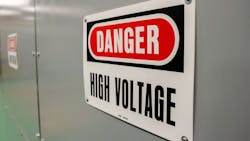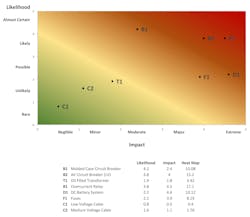Are you selecting the right PPE for your electrical system maintenance?
Not all electrical equipment is created equal when it comes to production objectives versus safety objectives in an electrical power system. Certain devices should be tested and maintained to ensure uptime; others should be tested and inspected to ensure they perform properly to protect workers in case of an arc flash event.
When considering arc flash safety and selecting the appropriate PPE, the condition of maintenance for protective devices or circuit breakers is certainly much more critical than for a conductor or load device. This article outlines why evaluating each piece of an electrical power system’s equipment for its impact on productivity and safety is important to improving both reliability and worker safety.
Condition of maintenance can have an impact on PPE selection
PPE selection is based on a value for the expected incident energy exposure, whether using an incident energy analysis (arc flash study), the table method, or another process to determine arc flash values.
Incident energy values are largely based on a combination of circuit clearing time, distance from the source, and the amount of arcing current in amperes (among other factors). Since clearing time is one of the direct critical factors, PPE selection is based on the equipment operating (opening) speed. In an arc flash study or other calculation method, this speed is based on the equipment’s time-current operating characteristics to be in like-new condition. Even equipment that operates a fraction of a second slower can cause arc flash values to be substantially higher than anticipated or indicated on a label.
What does this mean? In one example, a worker can believe the incident energy is single-digit calorie exposure and dress accordingly; however, the actual clearing time of an unmaintained upstream device can potentially cause this value to be hundreds of calories! Not verifying clearing times essentially makes the arc flash label or table method of PPE selection invalid.
Condition of maintenance is now a key consideration in the overall risk assessment process. But how does this affect worker safety and PPE selection? We looked at this several years ago and published a paper highlighting our findings. A 2008 paper at the IEEE Electrical Safety Workshop (IEEE ESW-2008-21) by Ron Widup and Kerry Heid used survey data from NETA accredited companies with survey results from over 340,000 protective devices. With service-aged equipment, we found that approximately 22% of circuit breakers had an issue with the protective trip unit. Experience tells us that trip units usually operate slower, not faster, so the arc flash energy values downstream of these devices would be higher than expected.
Even more alarming: 10.5% of circuit breakers would not trip at all, and 42.8% of these problems were mechanical. A circuit breaker that has not operated in years may not operate at all when called upon during an arc flash event. An inoperable protective device will create a high probability of extreme values of incident energy. It’s a scary scenario when selecting PPE.
The difference that asset class can make on choice of PPE
Table 1 lists six asset classes in an electrical power system that must be considered differently when it comes to maintenance on that system, based on production versus safety objectives.
Items such as cables, rotating equipment, and transformers can have a huge negative effect on productivity and uptime, but typically aren’t as likely to create a major safety risk (see Figure 1). Failure of these devices can cause power outages or lost production for days and even weeks depending upon the ability to replace or repair them. This will have a major financial impact on the organization, but typically a limited impact to personnel safety. (Note that the devices above in the Safety column can also affect production/uptime.)
In contrast, power systems apparatus such as circuit breakers, protective relays, and DC tripping power can directly affect overall electrical arc flash values and PPE selection (see Figure 2). These items can fail without anyone knowing they failed and thus won’t operate to clear a fault, but production continues on as normal. Failure of these devices to trip and limit the energy during an arc flash event creates a huge increase in the risk to the worker. These failures are normally only found during maintenance or when a fault occurs. For example, a transformer fire could be dangerous to workers. But what is the likelihood that a transformer would fail with someone standing directly beside it? In addition, for a transformer to catch fire or to catastrophically fail would mean that the protection failed, so the risk is associated with the protection, not the actual transformer failure.
The Canadian standard CSA Z463, Maintenance of Electrical Systems states that these critical safety devices must be included in the electrical maintenance program. The type and interval of maintenance is left up to each individual user based on their installation and operating environment. Production devices can be maintained at a different level based on the business decision by the organization, but devices that negatively affect electrical safety cannot be ignored.
Electrical safety heat map
Annex C of Standard CSA Z463 features a safety heat map that plots the likelihood of an occurrence versus the impact the device would have on worker safety should it become inoperable. Maintenance for safety objectives can be completely different than those for production objectives, and this is exactly what the safety heat map establishes for separate asset classes.
This system establishes unmaintained equipment in the green (low risk), yellow (moderate risk), and red (high risk) zones for their effect on the electrical safety program (see Figure 3).
- Likelihood is the chance the equipment would not work as intended (mis-operate) if it was completely ignored over a lengthy in-service period.
- Impact is the potential exposure to a worker should the equipment not work as intended.
Each piece of apparatus has a different risk factor for production and for safety, and it’s typically a business decision for production or uptime versus a safety decision for equipment that poses a risk to personal safety. The values in the tables are subjective and need to be aligned with the installed equipment vintage, loading, fault interruptions, operating environment, and apparatus manufacturer to rate the likelihood and impact of failure.
Low-voltage air circuit breaker: High risk
The on-board protection system in a low-voltage air circuit breaker (LVACB) includes a series trip unit or an electronic trip unit consisting of current transformers, wiring harness, protective relay, and some type of mechanical actuator. Maintenance staff must operate it on a regular basis to create an electrically safe working condition. When not exercised on a regular basis, these devices can become inoperable without any warning. Because they are rackable, frequently operated, and include a complete on-board protection system, the likelihood and impact variables on these devices are some of the highest in the electrical power system. As noted earlier, the NETA survey and associated IEEE paper showed that 22% of these breakers did not follow their time current characteristics, and 10.5% did not operate at all when service-aged maintenance was undertaken.
Power fuse: Moderate risk
Power fuses are protective devices that have no movable parts and are generally very reliable. However, they can create extended clearing time above expectation if not applied properly following a replacement-in-kind process. Electrical workers commonly replace a fuse with one that is adequate for the loading level but is not the correct size or rating as designed in the power system study or arc flash hazard analysis. This can create a much higher arc flash value than anticipated.
Buried underground cable: Low risk
Buried underground cable has limited arc flash risk and associated PPE level because the likelihood of failure and impact to personal safety are both very low. These devices have no moving parts and are highly reliable if installed correctly. The likelihood of a failure is typically very low, and the impact this device could have on safety during a failure is quite low.
As seen in these three examples, the attention paid to maintenance depends on the likelihood the equipment will fail and the impact that it will have on worker safety. Power systems equipment that is more likely to fail and have a higher impact MUST be included in the electrical maintenance program due to the serious safety concerns it can bring.
In conclusion
Certain apparatus in an electrical power system can have a drastic negative impact on incident energy evaluations and the associated level of required PPE when not maintained properly. Field test data shows that a lack of maintenance can severely affect the operation of protective devices. Any item that can directly extend the tripping time of a protection system needs consistent maintenance and testing to ensure it operates according to its specified time-current characteristics. PPE selection and personnel protection is dependent on this equipment working properly, and an electrical maintenance program is critical to this expected operation.
An arc flash hazard analysis will usually indicate that protective setting changes can reduce the incident energy values and thus lower the level of PPE required. However, if these protective devices do not function as designed due to a lack of maintenance, the new energy levels are invalid and render the PPE assessment as inadequate. Arc flash studies should always indicate that any setting changes made to lower incident energy require testing of the devices to ensure they follow their time current characteristics.
About NETA
This article was provided by the InterNational Electrical Testing Association (NETA), www.NETAworld.org. NETA was formed in 1972 to establish uniform testing procedures for electrical equipment and systems. Today the association accredits electrical testing companies; certifies electrical testing technicians; publishes the ANSI/NETA Standards for Acceptance Testing, Maintenance Testing, Commissioning, and the Certification of Electrical Test Technicians; and provides training through its annual PowerTest Conference and library of educational resources.
About the Author
Kerry Heid
Kerry Heid is an Executive Consultant at Shermco Industries, a leader in electrical power systems reliability, engineering, and field services. After beginning his career with Westinghouse Service, Kerry founded the Magna Electric Corporation (MEC) office in Regina, Saskatchewan and then served as CEO of Shermco Industries Canada until 2019. Kerry is a NETA Certified Level IV test technician and is active in Canadian standards development. He has served as Chair of the CSA Z463, Maintenance of Electrical Systems technical committee since 2010, served on NETA’s Board of Directors from 2003–2014, is a past-President, and received NETA’s Outstanding Achievement Award in 2010.




